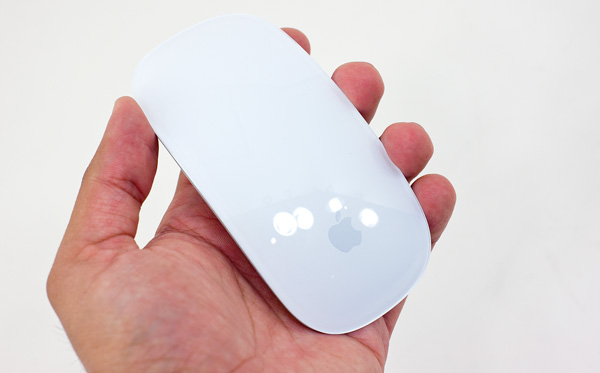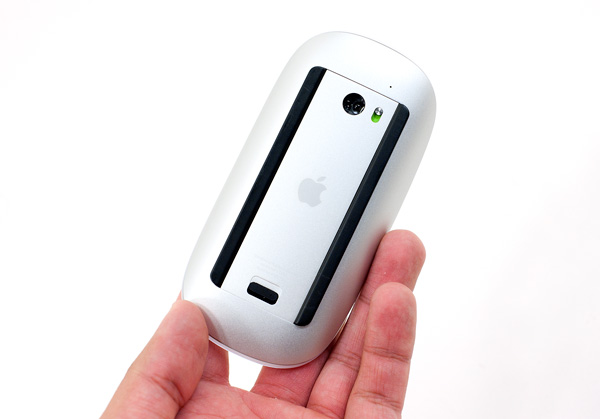Apple Mac Pro (Mid 2010) Review
by Anand Lal Shimpi on October 6, 2010 9:26 PM ESTInput Devices
The Mac Pro ships with two input devices by default: the Apple USB keyboard with numeric keypad, and the Magic Mouse.
The keyboard I'm a huge fan of. If you're ok with the relatively condensed design, it's great to type on. The angle feels just right, there's good feedback from the keys and even the key travel seems just right. The biggest issue is that it isn't an ergonomic design in the style of the Microsoft Natural keyboards.
You get a row of helpful function keys along the top and two USB ports integrated into the keyboard itself. The ports are only good for delivering 100mA of power so you'll have to look elsewhere to charge your iPhone/iPod.
I've used the keyboard before, it's actually what I do most of my writing on. I'd say there's still tons of room for improvement in the comfort department so I'd like to see Apple go back to the drawing board with its now 3-year old design. The mouse however, I'd never had any real experience with.
The Mighty Mouse was Apple's first attempt at a two-button mouse with a modern Mac. By using a touch sensor in the mouse itself you could push on the right side of the mouse to simulate a right click. A nifty way of adding a right mouse button without actually capitulating to the demands of the radical two buttoners.
The successor to the Mighty Mouse is named the Magic Mouse. Stylistically the Magic Mouse is probably the best looking mouse I've ever used. It looks great on a desk. Even the on/off switch underneath is well designed. It also takes touch to the next level. Instead of using a touch sensor to simply determine left from right clicks, you can now gesture on the surface of the mouse.
The supported gestures include scrolling (both horizontally and vertically) and two finger swipe to flip through photos or web pages.
The scrolling gestures are nice. I found myself getting excited whenever I’d have a window open that I needed to scroll in. It’s just so much more effortless than using a scrollwheel, even the newer low-friction wheels. But at the end of the day I just couldn't get over the ergonomics of the mouse. Matthew Witheiler, the first AnandTech Senior GPU Editor, swears by his but I couldn't get used to it. The Magic Mouse is extremely low profile and doesn't really contour to my hand at all. I suppose it's ok for occasional mousing but I simply point too often.
The Magic Mouse also lacks the smooth tracking feel that most Microsoft and Logitech mice have. There are two plastic strips that run along the base of the mouse, serving as feet. They are solid plastic with no soft coating at all. If you use your mouse on a desk without a mousepad it feels like you're scraping the mouse across the desk rather than smoothly gliding it across. Even on a mousepad the feel isn't great.
If you like the idea of going all the way with touch on a desktop there’s also the optional Magic Trackpad. This one doesn’t come with the Mac Pro but it is a $69 option. And as its name implies, it’s a giant trackpad.
I was a lot happier with the Magic Trackpad than I was with the Magic Mouse. The gestures are easier to do and you get more of them. By far the most useful was sliding four fingers up or down on the trackpad to trigger different Exposé modes. Scrolling is also nice and smooth and the trackpad surface is arguably too big, I don’t use most of it but it’s nice to have.
My biggest issue with the Magic Trackpad is its positioning on my desk. Trackpads work on notebooks because they’re situated directly in front of your keyboard. Move your right hand down for tracking and back up for typing. On a desk the trackpad is physically a lot further away from your hands. You can position it in front of your keyboard but then it interferes with typing since the trackpad doesn’t lay flat on your desk.
You could argue that the trackpad is the same distance away from your hands as a traditional mouse, but I believe one of the benefits of a trackpad is its closer-than-a-mouse location. You lose that advantage with the Magic Trackpad.
Other than that it boils down to personal preference. While I have no problems using a trackpad on a notebook, at my desk I still use a mouse. The trackpad is nice for gestures but it’s not good for gaming and I find that I’m slower with it for precision movements than a mouse.
Both the Magic Trackpad and Magic Mouse are Bluetooth devices that rely on two AA batteries. The pairing process is simple under OS X, although it’s worth mentioning that you’ll have no mouse support until you do install Apple’s drivers under Boot Camp. That means you’ll have to go through the Windows install process without a mouse.
Assuming linear battery drain based on our testing we estimate around 6 months of battery life on the Magic Trackpad. I haven’t used the Magic Mouse enough to give you an equivalent estimate.
On the 2009 Mac Pro I noticed an issue with Bluetooth reception and the Magic Trackpad where I’d occasionally get a stuttery mouse cursor. Users have tracked this down to an issue with the Bluetooth antenna in the system not being sensitive enough. In my testing of the 2010 Mac Pro I haven’t been able to duplicate the problem but that’s not to say it’s gone entirely. It’s just that so far things have been fine.















84 Comments
View All Comments
mattgmann - Thursday, October 7, 2010 - link
I understand including a nice case, as the mac case is quality. But you're right, $250 is a bit steep. There are plenty of less expensive cases that are just as nice, and some real budget cases that would be serviceable.hellotyler - Thursday, October 7, 2010 - link
If I had the money, I'd buy one of these in a second. Apple rules. In today's world though, budget is important and PC beats out Apple heartily on the mid-powered PC market. I own both Mac and Pc (side by side, my two babies) and I love them both dearly. If I had to choose a brand new super powered computer though, I'd have to go with the Mac because of the OS.noiseunit - Thursday, October 7, 2010 - link
Maybe I'm missing something here but a quick search on newegg showed a $700 difference in the price of the graphics cards, maybe thats why the dell is so expensive?Stokestack - Tuesday, October 12, 2010 - link
The Mac IS a PC. If you mean a Windows system, then say that.ViperV990 - Thursday, October 7, 2010 - link
Didn't see it mentioned in the article, so I'm assuming no, but I want to double-check: Does the Mac Pro support 3x1 Eyefinity setup?Also, it's a shame that they're not offering the Eyefinity 5 or 6 models as an option.
Porksmuggler - Thursday, October 7, 2010 - link
Really appreciate the honest comparison to the custom built, but the Dell T5500 isn't exactly comparable. It's easy to say "other than the graphics card" but seriously:Apple's ATI Radeon HD 5770 1GB - $249 from Apple or $125 from Newegg
Dell's ATI FirePro V8700 1GB - $860 from Newegg
Anand Lal Shimpi - Thursday, October 7, 2010 - link
It's a tough comparison to make if you really want to dive into it. The FirePro price premium is due largely to the driver work and it's tough to tell what equivalent driver work (if any) Apple has done in OS X. Either way, it does change things quite a bit and I've updated the text to reflect that there is an Apple tax that's just hidden by the GPU cost differential.Thanks for the comment :)
Take care,
Anand
Porksmuggler - Thursday, October 7, 2010 - link
Thanks for the update, it truly is a tough comparison.I think an even greater concern with both the Dell and Apple tax is that both are using what might be considered as "commodity components"; Apple certainly would be using Foxconn, and I do not know of Dell's core supplier. The point being, these components do not have the same reputation of quality and performance as those used in the custom built.
The extent of the tax goes even further...
Sunburn74 - Thursday, October 7, 2010 - link
Not sure how you managed to reach the $324 number you published in the edit in the article. The cheapest fireprov8700 I can find costs 600 flat (ebay buy it now). The difference is at least $500 once you deduct the street costs of the packaged gpu.jecs - Thursday, October 7, 2010 - link
To me the "why a Mac Pro" is I have been afraid to build myself a solid dual socket PC workstation class machine for Pro 3D modeling, rendering and compositing with Maya and Final Cut Pro. But now I am very used to some pro Apple and none Apple software and happy. So in my case my current 2.8 octacore has been very, very reliable. For graphic design I agree it gets more difficult every time to justify a dual socket machine like a Mac Pro. Why 8-12 core for illustrator or even Photoshop?, Get the fastest quadcore PC for this. But also is a matter of personal preference.The Mac Pro is not the fastest machine out there but not either the most expensive or exotic hardware as there are usually faster PC hardware and more specific software options and features. But, if you like me are using specific multithreaded Pro software with decent performance and like OSX, then the Mac Pro is very solid. No Mac Pro has died on me yet, they are easy to upgrade for the most common features, work very well out of the box, is reliable, offers dual socket options and no Apple tax on comparable Dell or similar workstations.
On the other hand, even I use the Mac Pro all day long I builded a SFF quad core PC and this is the machine I am going to upgrade this year. The PC is "my back up" machine but the one that goes outside with me when I need performance, and also one very useful rendering machine.
By the way Anand, very good article! I enjoyed very much reading through the lines, not defensive at all, not too long and I learned on some features and coments. At least to my experience as a Mac Pro user from the beginning and even from the days of the G5s.